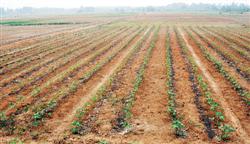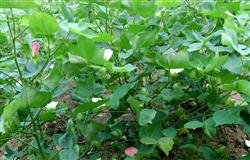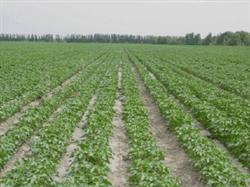Technical guidance of Cotton production in Spring in the Cotton area of the Yellow River Basin

Seedling transplanting is light and simple. First, choose a good breeding base. It requires high-rise terrain, leeward to the sun, water and convenient transportation. Second, prepare the materials. The seedling bed was made by using seedling substrate and clean river sand or loaded into a hole plate instead of a nutrition bowl, and the sufficient materials were prepared according to 500 seedlings per square meter seedling bed. Third, sow seeds at the right time. Garlic cotton field and wheat cotton field are generally sown in early April, interplanted in early May, and the seedling age is about 30 days. Fourth, seedbed management. Root-promoting agents are used to irrigate and soak roots to control the formation of "high-foot seedlings" in high-density seedling beds to promote the growth of new roots. Fifth, transplanting. Artificial transplanting of garlic in cotton field, mechanical transplanting of wheat, cotton after garlic and cotton after wheat, transplanting density of 3000 plants / mu, and watering "settling water" in time after planting. Sixth, large-scale seedling cultivation to implement the "three-point" plan. That is, sowing, raising seedlings and transplanting in stages and batches. The use of medium and large bowl type is recommended for seedling raising in nutrition bowl. Fertilize the bed soil, make enough bowls according to the transplanting density plus 20%, sow one grain in each bowl, and pay attention to prevent the harm of diseases and insect pests and weeds in the seedbed. Drilling and transplanting, other management is the same as simple seedling raising. Drought resistance, seedling mulching and soil moisture preservation are waiting for sowing. If there is effective rainfall before the suitable sowing time, the moisture can be preserved by plastic film mulching first, and then sowing until the suitable sowing time, which can ensure a higher emergence rate. Ditch casting and film coating. If there is no effective precipitation before sowing, it can be ditched before sowing, watered in the ditch, then sowed with soil, and then covered with plastic film, which is suitable for protecting seedlings in dry land. "Water seed bag". Dig a pit for artificial watering and sowing, and cover the soil above the ground to form a soil bag. Soaking seeds to accelerate sprouting. In the cotton field with poor soil moisture, the cottonseeds are soaked in water until the cotyledons are delaminated, and after being exposed to the sun or heating, the radicles are exposed to the seed coat (commonly known as white), and then ditched and planted; when the moisture is good for sowing, the seeds can only be stuffed without sprouting (the coated seeds can not be soaked, but once soaked with the seed coating agent, the seeds will fall off, causing rotten seeds and rotten buds). The sowing method is determined according to soil moisture. Those with good soil moisture (about 2 cm in dry soil layer) can be sown directly; those with good soil moisture (about 4 cm in dry soil layer) can first be suppressed to increase soil moisture or "dry and wet"; those with poor soil moisture (more than 5 cm in dry soil layer) use the "deep sowing" method to deep down the seeds to 2 cm below the wet soil, and so on most of the cottonseed "top soil", and then use the soil divider to sow the dry soil on the covered seeds and lift them to the back of the ridge.
- Prev

Deep-buried drip Irrigation Technology of Cotton
In order to sow the whole seedling, strong seedling and early development of cotton, and to achieve high yield and high benefit, it is necessary to grasp the following key techniques: 1. Select varieties with high yield and disease resistance. The main varieties of large-scale demonstration planting in our county are Jiza 1, Ji 2000, Ji 228, Hengmian 4 and so on. 2. Scientific and balanced fertilization. It is necessary to master the combination of organic fertilizer and chemical fertilizer.
- Next

Do a good job of cotton late ripening and improve cotton quality and benefit
The fundamental measures to prevent premature senescence of cotton should start with strengthening the basic construction of cotton field, that is, deep ploughing and fine harrowing of cotton field, increasing application of organic fertilizer and keeping balance of various elements in soil. When cotton enters the late stage of growth, only the following remedial measures can be taken: First, fertilizer and water management should be based on cotton plant conditions.
Related
- The first cup of black tea in spring, the flavor and history of tea gardens in Kenya, Africa
- The computer can not only choose potatoes, but also grow tea rice. AI will grow winter oolong tea champion.
- It is not only the inflated tea bitten by insects, but also engraved with the four seasons tea in Beipu.
- The Oriental Beauty Tea Festival in Zhuxian County takes the stage at the weekend to experience the plus-size feast of oil tea.
- & quot; Oriental Beauty Tea & Exploration of Emei in Hsinchu, the hometown of quot;
- The new variety of strawberry "Tainong 1" dessert is the first choice with mellow aroma. Crimson gorgeous
- History of Tea in Taiwan: from Wild Inner Mountain to Export Tea Garden
- Two types of Taiwan Oriental Beauty Black Tea won the British three-Star Award for Childhood Tea Xiang Zhang Jiaqi changed from pilot to champion tea maker.
- Banana species and varieties: the planting history of Taiwan Xianren banana and dwarf banana is long, is banana disease resistant?
- Coffee planting Technology: Qianjie Coffee from Seedling to harvesting

